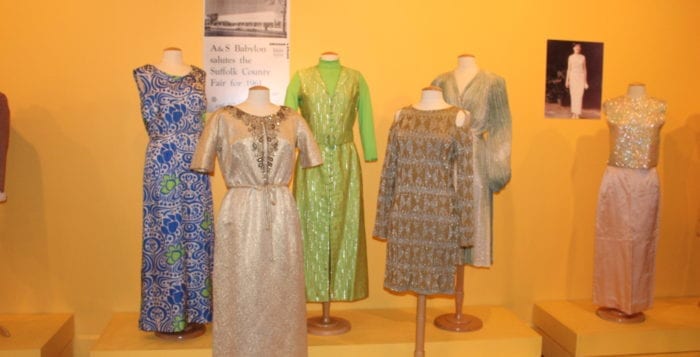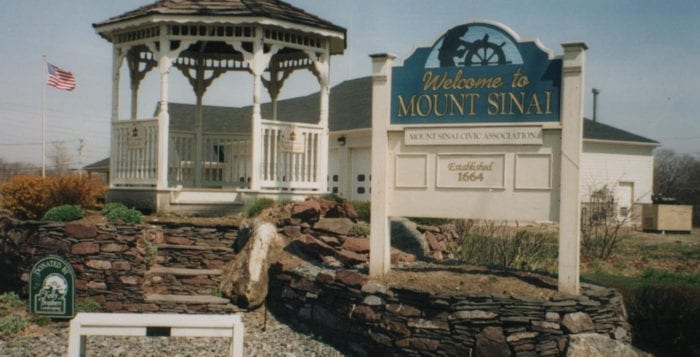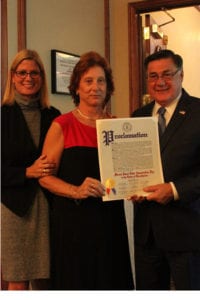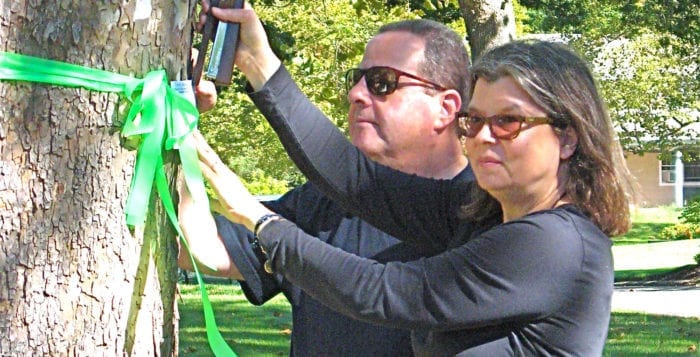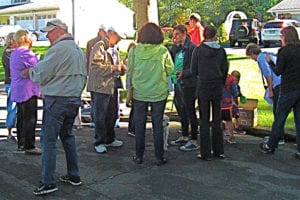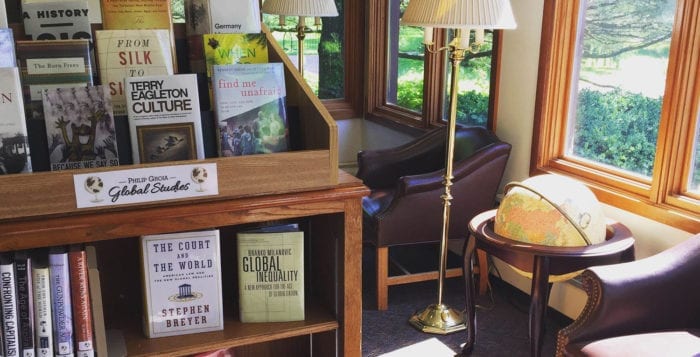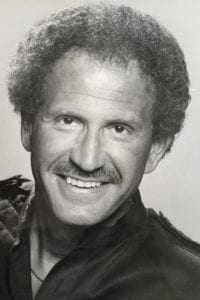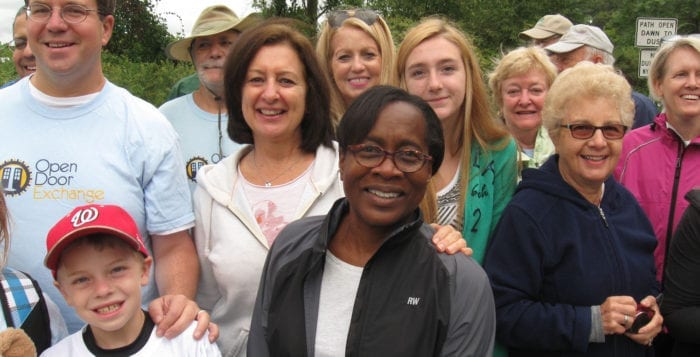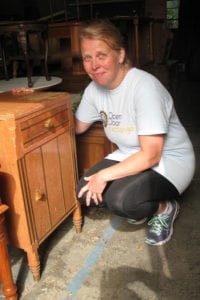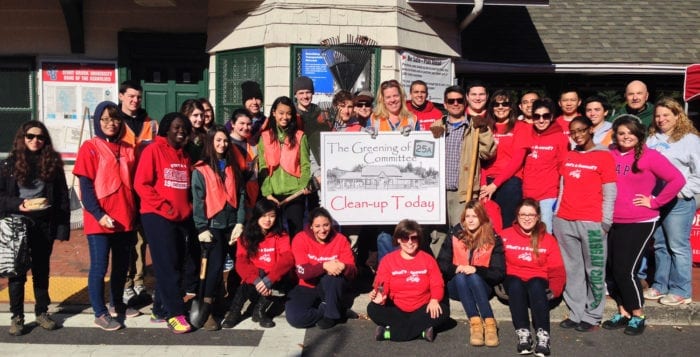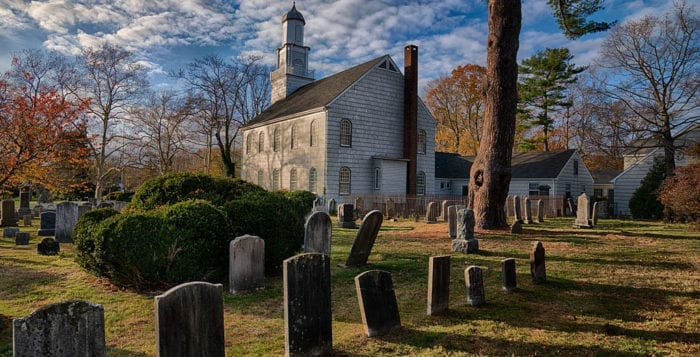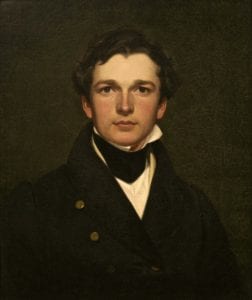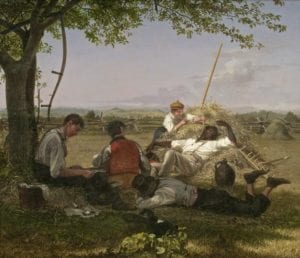By Kevin Redding
For Mike Meola, owner of Darkside Productions’ Haunted House in Wading River, summer begins and ends in June. After that, he’s in full Halloween mode. While others are at the beach in July and August, Meola surrounds himself with hanging scarecrows and skeletons, working tirelessly every year since 1998 to build the props, animatronics and elaborate, horror movie-quality sets that turn a vacant potato barn and a quiet stretch of fields on Route 25A into one of the most popular and visited haunted attractions in the country throughout October.
The North Shore native and full-time carpenter lives and breathes the spooky season, and his passion for scaring — and entertaining — people of all ages has brought a lot of attention to Darkside, which was recently featured on Buzzfeed’s list of “25 Haunted Houses Across America That Will Scare the Crap Out of You.” What started out as a mere love of Halloween and horror as a kid has escalated to a booming family business that has now entered its 19th season.
What got you interested in haunts?
I’ve been doing this since I was a kid. I used to build these haunted walk-throughs in my basement. I love Halloween, I always have. And back when I was growing up, there was no Spirit Halloween or anything so you had to make your costume and scour all different places to find what you wanted to use to build your costume. You would think way in advance, because you couldn’t just walk in the store and get it. After Halloween, I was already starting to think “what do I wanna be next year?” and went to clearance sales and any place where you can find a mask or something, and then run around for the rest. So it just really came from a love of Halloween.
What were your favorite horror movies growing up?
I liked all the killer movies — “Halloween,” “Friday the 13th,” “A Nightmare on Elm Street.” I thought Freddy was great for his interactions; most of the other ones didn’t speak or anything, but Freddy had really cool wise-ass phrases to say to everybody. The movie that scared me though when I was a kid was “The Exorcist.” That movie was terrifying. A killer getting shot a hundred times, getting up, getting burned, getting blown up, coming back isn’t scary to me. But the supernatural, that is scary.
What sets Darkside apart from other haunted attractions?
We’re a stand-alone haunt. We’re not a building that becomes a haunted house just for October. So when you get here, the moment you get out of the car, you’re in your own horror film. We’re in this deserted place in Wading River, so as soon as you exit the safety of your car, you get that sense of “Oh my God, I am in for a completely different experience!” because everything around you is haunted and in that foreboding atmosphere.
We don’t curse at you, we don’t grab you, we don’t touch you, we don’t do any of these “extreme” type things … because we don’t have to do that to scare you. We’re really good at setting up our scares, we’re really good at setting the scene and decorating, and our actors are phenomenal. Everything looks real! Once you enter the gates, you are in our world. The outside world completely ceases. And you won’t find a lot of off-the-shelf stuff here, because we build almost everything. It’s atmosphere. You have to have a great set, great lighting, great sound to build that tension. And the biggest challenge is creating this completely terrifying environment in the most safe environment [people] are in. They’re completely safe and yet they feel like they’re in imminent danger at all times.
How much work goes into Darkside each year?
People don’t realize the tremendous amount of work that goes into building an event like this. They think that it’s here, and little elves come and set it all up for me and I just come and open the door. Haunting is hard, hard work. We have to do repairs and maintenance, and come up with new room designs, build them. You’re doing that until the moment you open. On Friday at 6:59 p.m., there’s something I’m fixing or setting up before those doors open at 7. You’re never done.
Why do you think people love to be scared?
It’s exactly the same as riding a roller coaster. You know you’re safe, you know you’re strapped in and yet when you start going up and down and all over, you feel like you shouldn’t be there. It’s the same with a haunted house. It’s that adrenaline rush. It takes about 25 minutes to go through this place. Roller coaster rides are like two minutes long, but they feel like they’re five seconds. It’s the same thing here. People are screaming “I wanna get out! Is this over yet?!” and then they get out, and they’re so disappointed that it’s over. Even though they just want to get out, they don’t want it to end. I call it “vacation let down” the minute the door opens and they’re outside and safe.
Has the haunt more or less stayed the same over the years?
No, we change it every year. We’ve change the house completely in the last five years. We constantly change, add things, move things around, because we want to keep you guessing. If you came last year, we want to show you something different this year. Every year we say “how are we gonna top this show? There’s no way we’re gonna top this” and then every year we come up with something and add to that show, and it just makes it so much better.
What’s your all-time favorite room at Darkside?
One of the greatest things we’ve ever had was called “the falling wall.” We had this giant wall that came down right at you. It was just so unexpected, ya know? You walk in, and expect an actor or something, you never expect this 12-foot wall to come crashing down at you. That was a really cool effect and one of those things people still talk about. The fire marshall the other day was like “You have to bring that back! That was such a killer room!”
How many people do you hire every year?
During the season, we have about 40 [scare] actors. A lot of our actors come back every year, but we do interviews and auditions. We teach them how to be professional actors. They can work in any haunted house anywhere in the United States after working here. We teach them everything they need to know about timing, reading people, quick improvisation … we really try to personalize the show for each group that comes through. If we catch your name or something that you said, we’ll have a response. The actors have to be quick, have to pay attention, and it’s hard work. It’s physical activity, you jump and you move and you run. A lot of people don’t expect that.
How involved is your family?
We’re as grass roots as you can get. All my kids, my fiance, my mom, and my sister work here. My brother used to work here before he moved. It’s been a family business ever since we started. My son is an actor here but he also helps me build and set up, my daughter was an actor here but now she’s running our concession, my mom does tickets, my sister does the daytime show tickets, my other daughter is an actor here. Kathy, my fiance, is a manager. It’s great, it brings us all together. I’m surrounded by family and if they weren’t working here, I’d never see them in October!
What age group seems to enjoy Darkside the most?
I’d say our biggest fan base is older. We do get a lot of teenagers, but we have a lot of older people who love Halloween and love haunted houses. They know that this is a great show and if they’re coming to one, they’re coming here. You would think that it would be all teenage girls, but it’s not. It’s really a lot of 25 to 35, 35 to 40-year-olds. It’s an older crowd, which is cool because we’re scaring them! To me, a kid is an easy scare. I want to scare adults!
Darkside Haunted House, 5184 Route 25A, Wading River is open through Oct. 31. Tickets are available at the door or online at www.darksideproductions.com or at www.ScreamLI.com.


